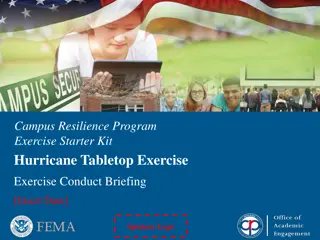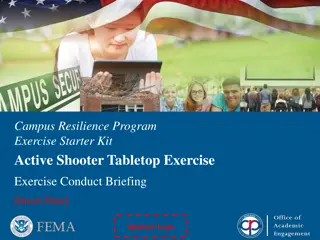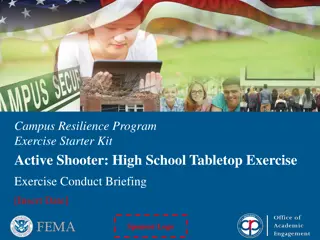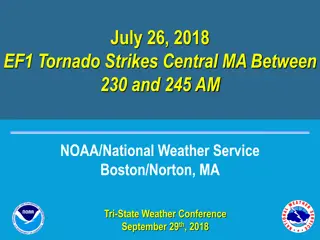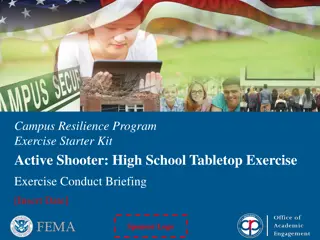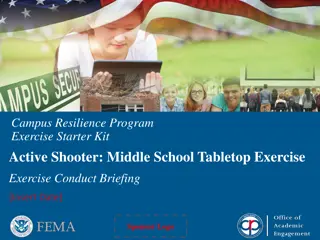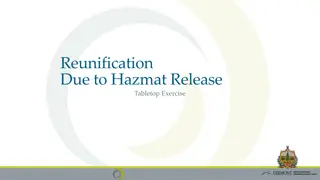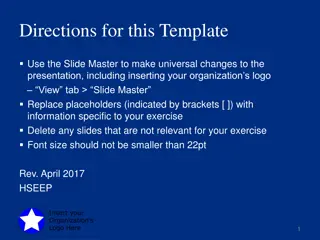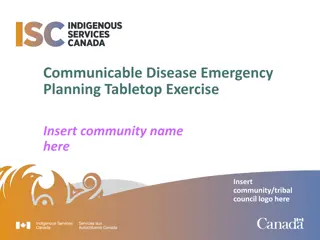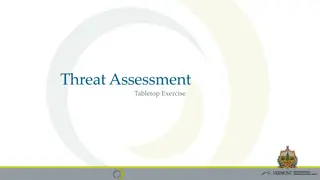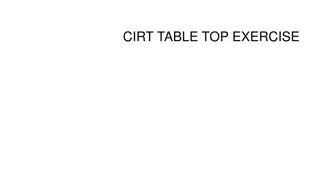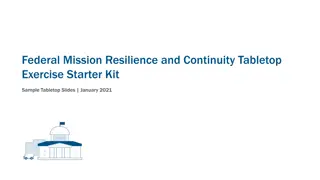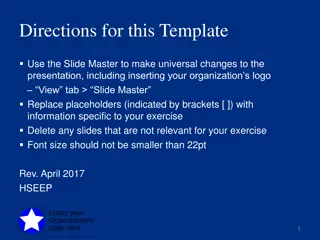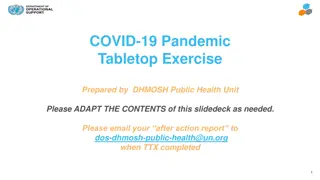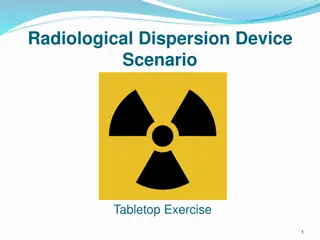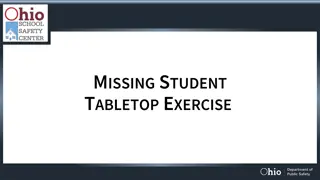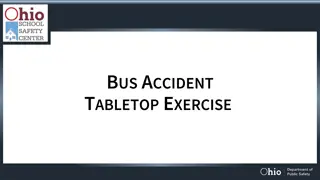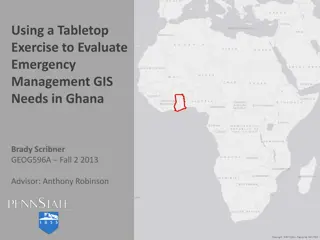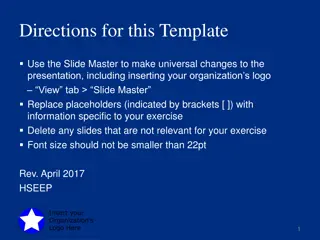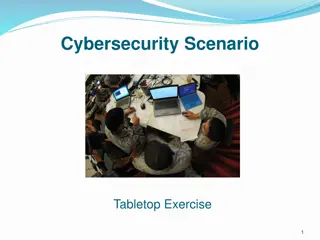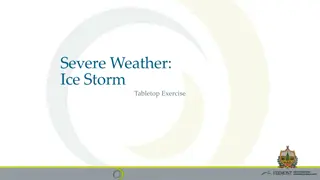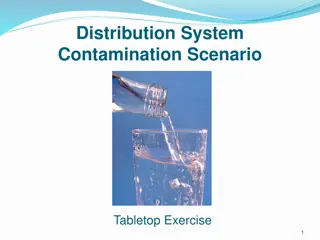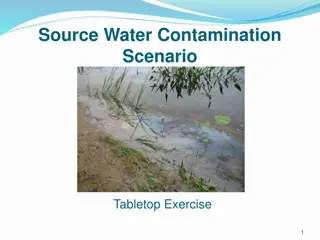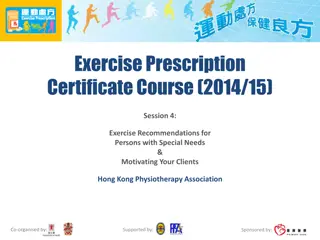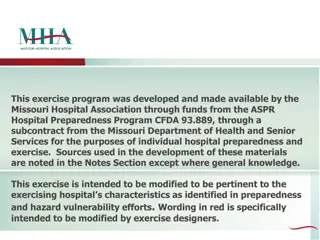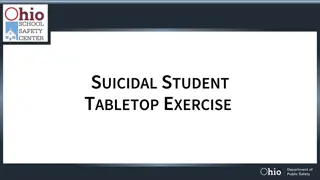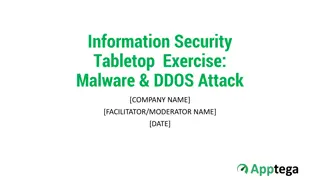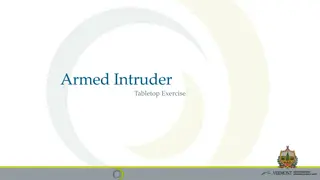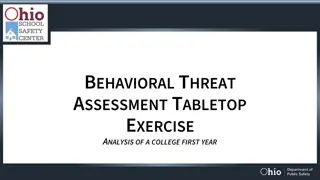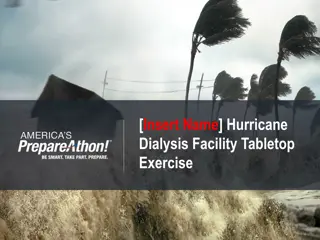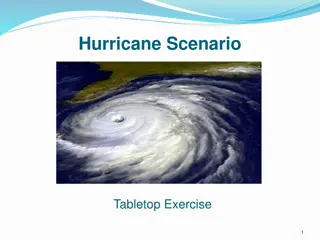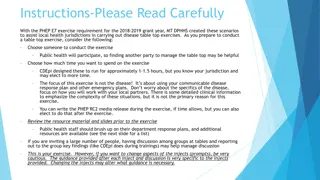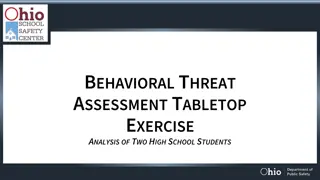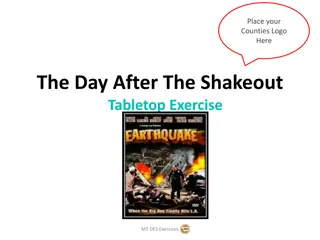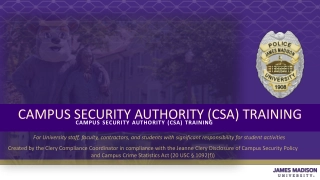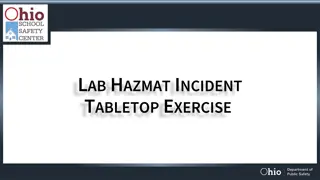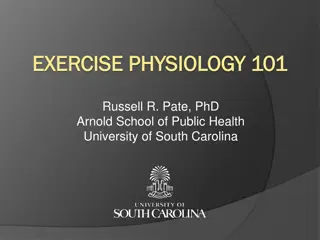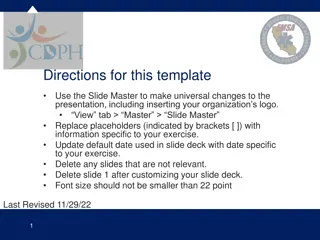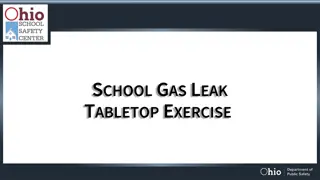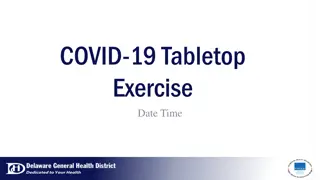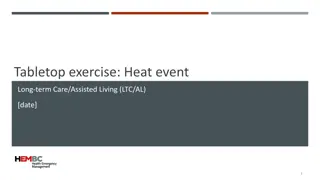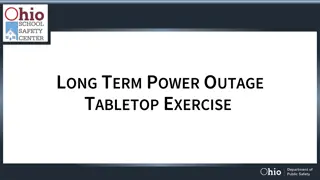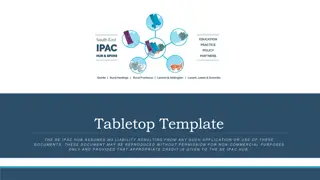Campus Resilience Tornado Tabletop Exercise - Overview and Briefing
This document serves as a baseline exercise briefing for higher education institutions to evaluate their emergency plans and procedures in the face of an EF3 tornado scenario. It provides a structured approach to assess preparedness, response, and recovery operations, aligned with the Campus Resilience Program Exercise Starter Kits. The content can be customized by filling in the highlighted sections, offering a comprehensive framework to enhance campus resilience.
Uploaded on Oct 07, 2024 | 0 Views
Download Presentation

Please find below an Image/Link to download the presentation.
The content on the website is provided AS IS for your information and personal use only. It may not be sold, licensed, or shared on other websites without obtaining consent from the author. Download presentation by click this link. If you encounter any issues during the download, it is possible that the publisher has removed the file from their server.
E N D
Presentation Transcript
Campus Resilience Program Exercise Starter Kit Tornado Tabletop Exercise Exercise Conduct Briefing [Insert Date] Sponsor Logo Sponsor Logo
READ FIRST The purpose of this Exercise Conduct Briefing is to provide a baseline exercise document that institutions of higher education can use to assess their emergency plans, policies, and procedures The sample content contained in this document can be tailored as necessary by filling in all [bracketed content that is highlighted in red] To insert the sponsoring organization s logo, navigate to the View menu and select Slide Master This briefing is to be used in tandem with the Tornado Situation Manual and Facilitator Guide so any changes made to this briefing will need to be aligned with those documents **Delete slide prior to conduct**
Welcome and Introductions [Name] [Title] [Department/Agency/Organization] [Name] [Title] [Department/Agency/Organization] Sponsor Logo 3
Administrative Remarks Cell phone etiquette Evacuation procedures Restroom locations Sponsor Logo 4
Exercise Schedule Activity [Welcome and Introductions] [Exercise Overview] Module 1: Preparedness Break Module 2: Response Break Module 3: Recovery Break [Exercise Hot Wash] [Closing Remarks] Time [00:00 a.m.] [00:00 a.m.] [00:00 p.m.] [00:00 p.m.] [00:00 p.m.] [00:00 p.m.] [00:00 p.m.] [00:00 p.m.] [00:00 p.m.] [00:00 p.m.] Sponsor Logo 5
Exercise Overview Sponsor Logo 6
Exercise Overview Background: This Tabletop Exercise (TTX) is made available through the Campus Resilience (CR) Program Exercise Starter Kits Each Exercise Starter Kit aims to support practitioners and senior leaders from the academic community in assessing emergency plans, policies, and procedures while also enhancing overall campus resilience Purpose: This specific Exercise Starter Kit will provide the opportunity to examine preparedness, response, and recovery operations related to an EF3 tornado Sponsor Logo 7
Exercise Overview (cont.) Scope: This [insert duration]-TTX is divided into three Modules: Module 1 will examine tornado preparedness efforts Module 2 will examine response efforts in the aftermath of an EF3 tornado Module 3 will examine recovery operations following an EF3 tornado Each Module will consist of two activities: 1. Scenario Overview: Each Module will contain a detailed overview of the scenario 2. Facilitated Discussions: Participants will engage in facilitated discussions surrounding a set of discussion questions Sponsor Logo 8
READ FIRST The exercise objectives contained in the following slide(s) are provided as sample objectives These can be tailored as appropriate to align with the overarching goals and desired outcomes for the exercise Please note that changes made to these objectives will need to be reflected in the associated Facilitator Guide and Situation Manual for this scenario **Delete slide prior to conduct**
Exercise Objectives 1. Operational Coordination: Assess the ability to establish and standardize protocols for integrating whole community partners into a unified and coordinated operational structure during planning, response, and recovery efforts Physical Protective Measures: Implement and maintain risk-informed countermeasures and policies protecting people, borders, structures, materials, products, and systems associated with key operational activities and acritical infrastructure sectors Health and Social Services; Mass Care Services: Examine strategies to provide, restore, and improve life-sustaining health, human, and social services within affected populations following a disaster Public Information and Warning: Review the processes related to disseminating time-critical, operational, and incident-related intelligence and information to the whole community Infrastructure Systems: Stabilize critical infrastructure functions, minimize health and safety threats, and efficiently restore and revitalize systems and services to support a viable, resilient community 2. 3. 4. 5. Sponsor Logo 10
Participant Roles and Responsibilities Facilitator: Provides situation updates and facilitates discussions Players: Respond to the situation presented based on current plans, policies, and procedures Observers: Visit or view selected segments of the exercise without directly engaging in exercise discussions Support Staff: Performs administrative and logistical support during the exercise (e.g., registration) [Insert additional participant roles as appropriate] Sponsor Logo 11
Participating Organizations [Insert Participating Organization] [Insert Participating Sub-Organization] [Insert Participating Organization] [Insert Participating Sub-Organization] [Insert Participating Organization] [Insert Participating Sub-Organization] Sponsor Logo 12
Exercise Guidelines This exercise is being conducted in an open, low-stress, no-fault environment; varying viewpoints, even disagreements, are expected Act in real-world roles for your institution or organization when considering the scenario Decisions are not precedent-setting; this is an open discussion The focus should be on identifying suggestions and recommended actions for improving preparedness, response, and recovery efforts [Insert any additional guidelines that may be relevant to the exercise] Sponsor Logo 13
Assumptions and Artificialities The exercise scenario is plausible and events occur as they are presented Players will use existing plans, policies, procedures, and resources to guide responses There is no hidden agenda nor are there any trick questions The scenario assumes certain player actions as it moves through each phase; players should first discuss the actions stipulated by the scenario Players are welcome to engage in what if discussions of alternative scenario conditions [Insert any additional assumptions or artificialities that may be relevant to the exercise] Sponsor Logo 14
Start of Exercise Sponsor Logo 15
Module 1: Preparedness Sponsor Logo 16
Module 1: Scenario Overview [Insert Date and Time] A large system of severe thunderstorms begins moving into your area; the National Weather Service (NWS) reports that the conditions are favorable for the development of tornados Later that day, a large tornado is reported to have passed north of your area, devastating parts of the affected town Figure 1: Funnel Cloud Forms Local and state media report more than a dozen missing persons and several fatalities, in addition to significant damage to buildings, roads, and power lines Local officials advise residents of your area to familiarize themselves with tornado safety practices Sponsor Logo 17
Module 1: Scenario Overview (cont.) [Insert Date and Time] The NWS issues a Tornado Watch for your town, including the area surrounding [insert institution name] Other institutions in the surrounding area begin cancelling classes, athletic events, and social functions, and several of your student groups ask whether they should postpone their own scheduled events Visiting professors and administrators who had been invited to an academic conference call to ask whether it is safe to travel to your institution Faculty members and students express concern over the impact of power outages or systems damage on research equipment and perishable materials Sponsor Logo 18
Module 1: Discussion Questions (1/4) Operational Coordination 1. What plans, policies, and procedures does your institution have in place to prepare for a tornado? 2. Who in your organization is responsible for monitoring NWS alerts or would likely receive a bulletin from some other alerting authority? 3. What are your institution s initial priorities after a Tornado Watch has been issued? 4. How would your institution establish a command structure to coordinate your preparedness and mitigation efforts? 5. What resource gaps could limit your institution s ability to prepare for a tornado? 6. [Insert additional discussion questions as appropriate] Sponsor Logo 19
Module 1: Discussion Questions (2/4) Physical Protective Measures 1. What risks does a tornado pose to your institution s key assets and systems (e.g., campus facilities, critical infrastructure)? 2. What steps can your institution take to protect your critical operations? 3. What steps can your institution take to mitigate a temporary loss of critical operations? 4. [Insert additional discussion questions as appropriate] Sponsor Logo 20
Module 1: Discussion Questions (3/4) Health and Social Services & Mass Care Services 1. Are there identified locations where people should go in the event of a tornado? 2. What plans, policies, and procedures does your institution have in place to ensure all students, faculty, and staff are safely sheltered in case of a Tornado Warning? 3. [Insert additional discussion questions as appropriate] Sponsor Logo 21
Module 1: Discussion Questions (4/4) Public Information and Warning 1. What plans, policies, and procedures does your institution have in place to guide your internal and external communications strategies? 2. How and when does your institution issue warnings, alerts, and other emergency messaging? 3. What individual, office, or department coordinates and delivers your institution s public messaging? 4. How does your institution encourage students, faculty, and staff to take individual steps to mitigate the potential impacts of a tornado? 5. How will your institution use social media platforms in support of incident communications and public messaging? 6. [Insert additional discussion questions as appropriate] Sponsor Logo 22
Break Sponsor Logo 23
Module 2: Response Sponsor Logo 24
Module 2: Scenario Overview (1/3) [Insert Date and Time] The NWS Issues a Tornado Warning for your area [Insert Date and Time] Figure 2: Tornado Making Landfall Fifteen minutes later, a large tornado passes through the [insert institution name] campus, causing immediate power outages and structural damage to several academic and administrative buildings The wind funnel also sweeps through parking lots, tearing cars apart and littering the campus with debris Uprooted trees and airborne debris sever power lines, obstruct nearby roads, and cause additional structural damage to [insert institution name] buildings Sponsor Logo 25
Module 2: Scenario Overview (2/3) [Insert Date and Time] In the immediate aftermath of the tornado, your institution receives multiple unconfirmed reports of students trapped beneath the rubble of damaged buildings Many faculty members and students have suffered injuries that require treatment or hospitalization, and at least six people are currently unaccounted for, including two students with access and functional needs and one international student Large sections of the [insert academic building] roof have caved in, and portions of the [insert institution name] dining hall as well as several residential buildings have suffered significant structural damage Sponsor Logo 26
Module 2: Scenario Overview (3/3) Large quantities of debris and several uprooted trees have blocked [insert nearby road], limiting access to your institution and delaying response operations In addition to communication disruptions, downed power lines have resulted in widespread power outages throughout the area, including in most of your institution s residential buildings [Insert Date and Time] The two students with access and functional needs, the international student, and three members of staff, have not yet been located Furthermore, your institution learns that a hospitalized student has died from injuries sustained during the tornado After local media reports several more tornado-related fatalities within your area, your institution receives a flood of calls and emails from anxious families who have been unable to contact their children Sponsor Logo 27
Module 2: Discussion Questions (1/4) Operational Coordination 1. What are your institution s initial priorities after a Tornado Warning is issued? 2. What plans, policies, and procedures does your institution have in place to guide response efforts? 3. How would your institution establish and maintain an effective command structure to coordinate emergency response efforts? 4. How do key decision-makers collect information on damages and critical needs? 5. What resources are currently available? 6. Who are the key external stakeholders that would support response efforts? 7. [Insert additional discussion questions as appropriate] Sponsor Logo 28
Module 2: Discussion Questions (2/4) Infrastructure Systems 1. How will your institution facilitate the speedy restoration of critical infrastructure systems and services? 2. How would your institution coordinate the restoration of critical infrastructure? 3. What mechanisms does your institution implement to ensure continuity of operations during this response period? 4. How does your institution collect real-time updates on the status of its critical infrastructure? 5. [Insert additional discussion questions as appropriate] Sponsor Logo 29
Module 2: Discussion Questions (3/4) Mass Care Services 1. Who is responsible for tracking injuries, fatalities, and missing persons in the aftermath of a tornado? 2. What plans, policies, and procedures does your institution have in place to ensure the life safety and health of all students, faculty, and staff? 3. What resource gaps could limit your institution s ability to provide mass care services? 4. What emergency housing plans, policies, and procedures does your institution have in place? 5. What resource gaps could limit your institution s ability to meet your community s emergency housing needs? 6. [Insert additional discussion questions as appropriate] Sponsor Logo 30
Module 2: Discussion Questions (4/4) Public Information and Warning 1. How does your institution ensure consistent and coordinated public messaging throughout the initial response period? 2. How does your institution ensure timely and accurate situational updates for internal stakeholders throughout the response period? 3. Does your institution have a crisis communications plan or other means of communicating with all stakeholders in case of a breakdown of standard communications? 4. How does your institution notify families, key stakeholders, and the public of fatalities or serious injuries? 5. [Insert additional discussion questions as appropriate] Sponsor Logo 31
Break Sponsor Logo 32
Module 3: Recovery Sponsor Logo 33
Module 3: Scenario Overview [Insert Date and Time] Roughly 48 hours later, a NWS storm survey team classifies the tornado as an EF3 Roadways leading to and from your institution remain partially clogged with debris, worsening traffic and causing several accidents Power outages continue across your campus; additionally, multiple academic and administrative buildings require repairs and some student housing facilities remain uninhabitable Figure #3: Tornado Damage All six missing persons have been recovered and hospitalized for injuries sustained during the tornado; there have been an additional [insert number] fatalities among faculty and staff, and [insert number] remain in critical condition Sponsor Logo 34
Module 3: Scenario Overview (cont.) [Insert Date and Time] Over the course of the following week, students and families contact faculty and staff asking how class cancellations will impact their academic schedules as well as financial requirements and obligations The families of international students also reach out to their embassies and consulates requesting information on how class cancellations could impact their children s immigration statuses Sponsor Logo 35
Module 3: Discussion Questions (1/4) Operational Coordination 1. How does your institution coordinate the transition from response to short-term recovery efforts? 2. What plans, policies, and procedures does your institution have in place to guide recovery efforts? 3. What resource gaps could limit your institution s ability to meet these priorities? 4. What funding and assistance programs (e.g., FEMA grants) may be available to you and your institution in the aftermath of a significant tornado? 5. [Insert additional discussion questions as appropriate] Sponsor Logo 36
Module 3: Discussion Questions (2/4) Infrastructure Systems 1. Which infrastructure systems would your institution prioritize during the recovery period? 2. How would your institution coordinate the complete restoration of critical infrastructure? 3. What mechanisms does your institution implement to ensure continuity of operations during this response period? 4. [Insert additional discussion questions as appropriate] Sponsor Logo 37
Module 3: Discussion Questions (3/4) Mass Care Services & Health and Social Services 1. What plans, policies, and procedures does your institution have in place to return your campus to a healthy and safe environment? 2. What long-term housing plans, policies, and procedures does your institution have in place? 3. What resource gaps could limit your institution s ability to meet your community s long-term housing needs? 4. [Insert additional discussion questions as appropriate] Sponsor Logo 38
Module 3: Discussion Questions (4/4) Public Information and Warning 1. How does your institution ensure consistent, coordinated public messaging throughout the recovery period? 2. How does your institution provide internal stakeholders with timely updates concerning recovery efforts? 3. Who is responsible for monitoring and managing inquiries from affected students, faculty, staff, and alumni? 4. [Insert additional discussion questions as appropriate] Sponsor Logo 39
Break Sponsor Logo 40
End of Exercise Sponsor Logo 41
Exercise Hot Wash Sponsor Logo 42
Hot Wash Overview This Hot Wash aims to capture the following information based on observations made throughout the exercise: Overall strengths Overall areas for improvement Major takeaways and action items Sponsor Logo 43
Closing Remarks [Name] [Title] [Department/Agency/Organization] [Name] [Title] [Department/Agency/Organization] Sponsor Logo 44
Adjournment Sponsor Logo 45
Campus Resilience Program Exercise Starter Kit Tornado Tabletop Exercise Exercise Conduct Briefing [Insert Date] Sponsor Logo Sponsor Logo


